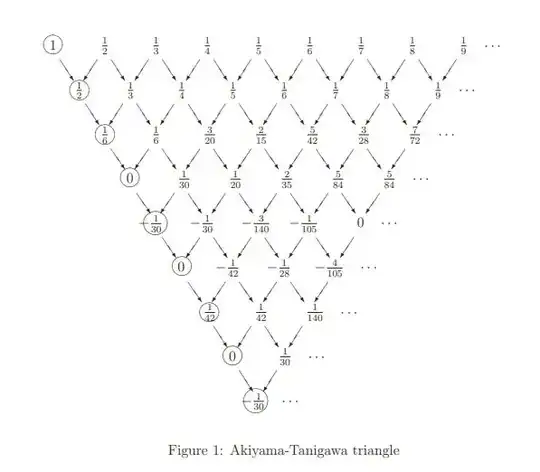On paper, what is the simplest way to generate the Bernoulli fractions like $\frac{-1}{30} $and $\frac{7}{6}$?
Basically I'm trying to find and understand $B_n =$ (the stuff on this side) and I've seen something using $i$ and a contour integral with
$$\frac{z}{e^z-1}\frac{ dz}{z^{n+1}}$$
and I don't pretend to understand that at all.
$$B_n=\frac{n!}{2\pi \color{red}{i}}\color{red}{\oint}\color{red}{\frac{z}{\color{black}{e\color{red}{^z}}}}\color{red}{\frac{dz}{\color{black}{e^{n+1}}}}$$
$$B_n=\sum^n_{\color{red}{k}=0}\frac{1}{\color{red}{k}+1}\sum^\color{red}{k}_{\color{red}{v}=0}(-1)^\color{red}{v}\color{red}{\binom{k}{v}}\color{red}{v}^n$$
and then there's this variant I see used a lot called a Generating function where
$$B_n = \sum \frac{1}{k+1} \sum (-1)v (k\dots v)v^n$$
but I don't understand double sums either. I need to be able to reliably get Bernoulli numbers for Taylor series stuff like tangent and the hyperbolic variants. I've reached a limit of my understanding and made clear in red the parts I'm confused about. Like I get that the $i$ is imaginary and somehow related to rotation of $\pi$, probably positive and negative, but I don't know what the $d$ or $z$ mean in that equation.
In the second formula, I don't understand why it switched from $n$ to $k$, then from $k$ to $v$, though I suspect I'm supposed to increment $1:1$ increases in $n$ for $k$, which also increases my increments for $v$ by $1:1$ (creating a $\frac{+1}{-1}$ sequence) but I don't understand the vertical parentheses at all. I'm not even going to pretend I took a class above calculus 1.
